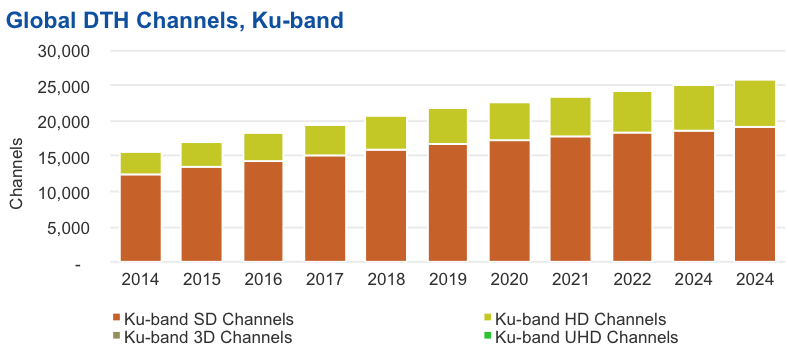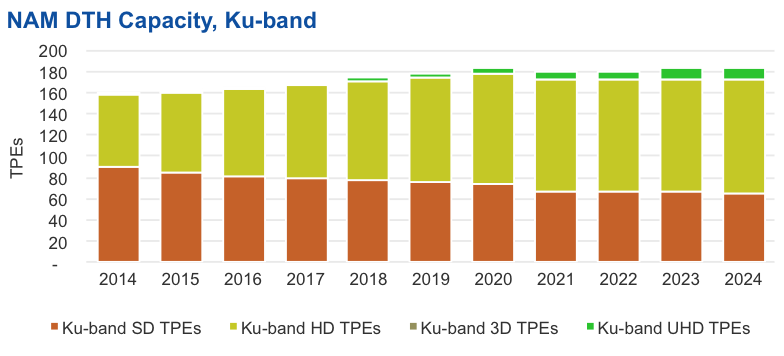Are OTT Concerns Over the Top?
Jun 9th, 2015 by
Alan Crisp, NSR
OTT seems to be wearing on the minds of many these days.
DTH and Cable TV platforms are perhaps the most threatened, given
the rise of OTT video products and the potential to reduce revenues
for video platforms and satellite operators alike. However NSR’s
latest report on the satellite video markets, Linear TV via
Satellite: DTH, OTT & IPTV, 8th
Edition finds that much of this concern is
unwarranted, with a few exceptions.
NSR forecasts that globally, DTH channels will increase to over
26,000 by 2024, representing a 67% increase over channel counts in
2014, with similar trends for both C-band and Ku-band video
distribution. This corresponds to 438 transponders of additional DTH
capacity required to handle this growth with a further 343
transponders for video distribution for Cable and IPTV headends.

The plethora of options for consuming video content has never
been higher, including (but not limited to):
ouTube
Netflix, now available in 80 countries worldwide, along with
similar service
Youku and iQiyi in China
OTT platforms provided by DTH and cable platforms
However, NSR found the rising OTT presence represents a growing
video market pie, rather than cannibalization of revenues. Instead,
cannibalization is in the form of viewing time, with consumers
spending less time viewing linear content and more on OTT content.
However, this doesn’t correlate to cord-cutting in most instances,
with the exception of the United States where a number of variables
have lined up to cause subscription cancellations to occur:
An existing very high pay TV penetration rate
Pay TV is a high cost as a percentage of income for many
households, whereas in many other regions, low income households
have never signed up for pay TV services
Plethora of options for OTT platforms, both free and paid
A home-grown advantage for OTT, as high percentage of high
quality content is produced in the U.S.
As a consequence, NSR expects leased DTH capacity growth in North
America to remain fairly soft over the next decade.
However, OTT is not a major cannibalizing factor elsewhere, where
there is insufficient incentive for consumers to cancel their pay TV
subscriptions, as much higher quality local content is available for
lower cost, and the lack of maturity of many OTT services and
oftentimes broadband (a key to solid OTT). Further, as economic
development expands in many developing regions, large numbers of
consumers are signing up for pay TV services for the first time,
boosting revenues globally. Instances of this include India,
Indonesia, and Brazil, with India having overtaken the United States
in 2014 for largest DTH market by total subscribers, for example.

Even with OTT acting as a form of complimentary competition,
there still remains significant DTH and cable growth opportunities
in most regions, which appear sustainable for a decade or more. For
instance, the Pay TV market in large parts of Sub-Saharan Africa
remains largely unregulated, with piracy being a major issue,
particularly with STBs flowing from South African DTH platforms to
other parts of the continent.
Some DTH platforms have been able to capitalize on OTT content to
expand their subscriber base and overall revenues, such as Sky
Deutschland and Sky Italia, and this is a trend which NSR expects to
become more prominent. Sky Deutschland (for example) saw their
largest subscriber increase ever in terms of total number of
subscribers in 2014.
And much longer term, after Internet connectivity and OTT become
much more ubiquitous, there is likely to be a trend for quality over
quantity for Linear TV content, including significant added capacity
from the higher bitrate UltraHD format.
Bottom Line
Although OTT is perceived as a fierce threat, in reality the
overall video market pie is increasing, rather than there being
cannibalization of Linear TV revenues in most regions. However, this
shouldn’t mean that video platforms should stay still. Rather, video
platforms will need to diversify to have an OTT product and become a
part of the continually expanding video market pie. 2015 is really
the beginning of the growth curve for OTT, and if traditional
platforms don’t step up and offer their own OTT products, their
dominance long term may be taken away by those who do.